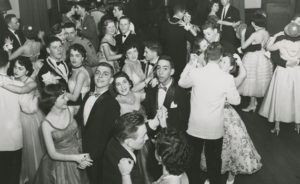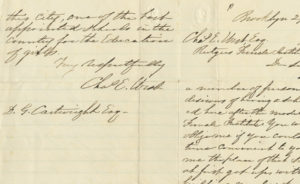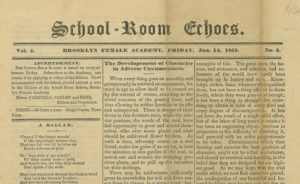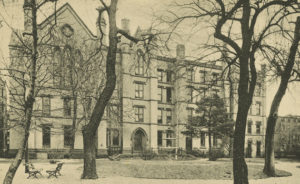The Packer Collegiate Institute: A Story of Education in Brooklyn
Just Keep Knitting
Georgia LaMacchia
For women during the second decade of the twentieth century, American society rapidly changed and World War I only accentuated these changes. Beyond the direct fear and shortages caused by a world war, intensifying suffragism, anti-war movements, increasing job opportunities for women, and the emergence of new immigrant communities added to the radical shifts mid decade. For wealthy young women at schools like Packer these shifts were evident. In the 1918 archival document the Means of Promoting the Sentiment of Patriotism in the Packer Collegiate Institute, it is clear that the Packer administration strongly supported American participation in World War I. The document lists fundraising efforts and pro-war lectures to educate the female students. However, it is unclear if individual Packer students fully supported the war as archival sources provide conflicting evidence on this issue. It seems that the main dichotomy of evidence exists between theory in a larger political sense and personal support within the surrounding neighborhood. The students debated the League of Nations on a philosophical level, but also knitted socks for soldiers on the personal level. The students held huge fundraisers for the Red Cross and Liberty Loan but wrote poetry expressing great unhappiness with the war.

Means of Promoting the Sentiment of Patriotism, 1918; Packer Collegiate Institute Collection, 2014
.019, Box 157, Folder 18; Brooklyn Historical Society.
Knitting was one of the main active ways women supported the war and it was seen as inclusive for everyone, wealthy to poor. A popular propaganda slogan for women on the home front was “Our Boys Need Sox, Knit Your Bit.” Packer publications, including the Autumn 1917 Packer Current Items, a quarterly literary magazine, contains two student written poems about knitting for the war and messages from the “Packer Knitting Klub” to knit for “our soldiers.” Packer students also participated in food conservation, Red Cross, and Liberty Loan campaigns. These fundraisers used popular support and propaganda to urge citizens to support the war. Additionally, propaganda was used in popular fiction, advertising, and films in order to curb dissent. Even education itself was considered an agent for propagandizing children and washing away seditious ideas. There was no evidence of any sedition, or seditious ideas from the women at Packer.

Packer Current Items, Autumn 1917; Packer Collegiate Institute Collection, 2014.019, Box 498, Folder 5; Brooklyn Historical Society.
Many women in the United States, especially those involved with the suffrage movement, did not support the War and saw it as “male insanity.” However, wealthy, female, educated New Yorkers, like those who would have attended institutions like Packer, actually transformed the movement by taking advantage of World War I as a way to influence the attitudes of American males. Women showed they deserved and could be trusted with the right to vote through wartime volunteerism and activities such as knitting. Women did their part to support the war just like men; therefore, they argued, they too could vote. However, young women at Packer didn’t necessarily play a large role in moving these societal movements forward, beyond small scale wartime volunteer work. Looking through archival sources about Packer students during this period, we can see that, although the girls might have been aware of and thought about these changes the majority of the students seemed to choose not to play a larger role in leading these movements even though their education would make them some of the strongest candidates. In fact, the girls that were ardent suffragists seemed to be looked down upon. Instead, it looks as if the girls focused their efforts on patriotism and supporting the war from at home through fund raisers and knitting. However, in 1917, when women finally won the vote in New York State, Packer did attempt to educate their female students with added courses in civil government.

The Yearbook 1915; Packer Collegiate Institute Collection, 2014.019, Box 412, Folder 2; Brooklyn Historical Society.
The views of Packer students during World War I present a dichotomy. On one hand, what took place at Packer reflects the pro-government patriotic view on the war, views that may or may not have been mandated by the school administration or the government. On the other hand, it is known that wealthy, educated women lead the feminist-pacifist and suffragist movements. As the young women graduating from Packer would have had some of the best education money could buy at that time, one might consider that they would have absorbed some of these more radical ideas. It is impossible for us to know the private thoughts of Packer students. They probably wouldn’t have been printed publically or saved in the archives. This lack of personal ideas makes it hard to know what individual students believed during World War I. It was hard, and often dangerous, to express private views in a time of propaganda and oppression.
May 2017





